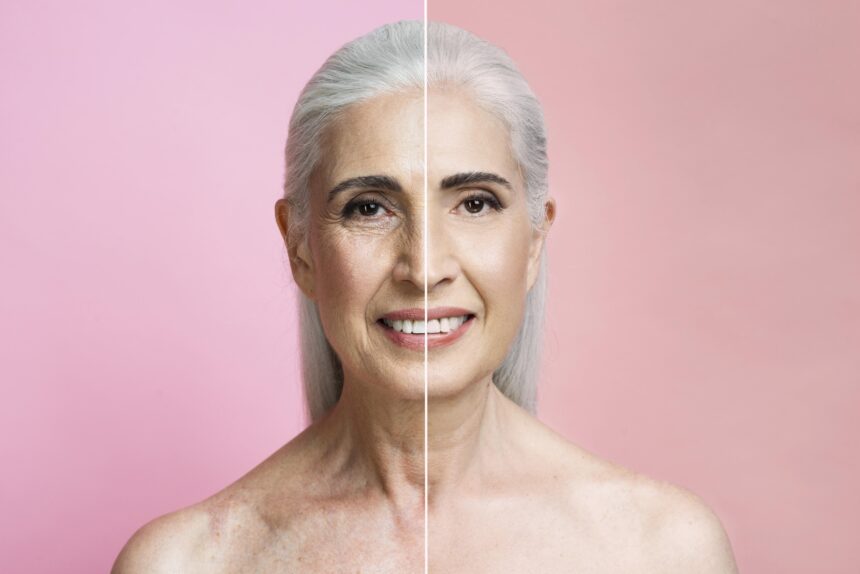The promise is intoxicating: skip the serums and patch the source code. Gene therapy says it can tune aging at the molecular level, not just hide it in the mirror. If that sounds like science fiction, welcome to 2025 — where venture-backed clinics, bold researchers, and skeptical regulators are negotiating the next decade of human longevity.
Let’s draw the line between dream and deliverable. “Anti-aging” is a cultural umbrella; gene therapy is a specific set of biological tools designed to alter or modulate gene expression. In practice, that can mean adding a working copy of a gene, silencing a harmful one, or using editing systems to make precise changes. In longevity, the goal is to target hallmarks of aging (inflammation, DNA damage, cellular senescence) in ways that improve function, not just aesthetics.
A good primer on the current scientific playbook is this peer-reviewed review of gene therapy strategies targeting aging-related diseases. It walks through vector choices (AAV, lipid nanoparticles), tissues of interest (liver, muscle, CNS), and early disease-specific wins (from retinal dystrophies to spinal muscular atrophy) that give researchers the confidence to attempt aging-adjacent targets. For the telomere-lengthening story you’ve seen on social feeds, it helps to anchor your expectations with a telomeres and aging overview — telomeres do correlate with aging biology, but turning that handle safely in humans is a complicated, tightly regulated task.
“Wild to imagine fixing aging at the DNA level — but show me the peer-reviewed receipts.” — a TikTok user
Bottom line: Today’s therapies can plausibly address aging mechanisms linked to disease risk and resilience. None of them can guarantee a “you, but 25 again” outcome — and anyone promising that on a brochure is selling vibes, not medicine.
Inside the mechanisms 🧬
Gene therapy isn’t one magic button; it’s a toolkit. Here are three levers that anti-aging clinics like to reference — and how they actually map to biology.
Telomeres: the cellular odometer
Those repeating DNA caps shorten with each cell division. Extend them and (the logic goes) cells might divide longer without hitting a stress signal. In animal models, telomerase activation shows tantalizing results. But translating that into safe, durable human benefits is a huge leap. Clinical programs must track oncogenic risk, delivery precision, and dose control with extreme care — the kind of rigor outlined in FDA guidance on genome-editing gene therapy.
Mitochondria: the cell’s power politics
Aging cells often have grumpy mitochondria: less ATP, more reactive oxygen species, and muddled signaling. Gene-level interventions try to nudge mitochondrial biogenesis, repair, or quality control (think PGC-1α pathways or mitophagy tuning). The target is performance and resilience: energy where you need it, fewer error messages mid-afternoon.
Senescent cells: the neighbors who never move out
Senescent cells stop dividing but don’t die; they secrete inflammatory factors that age tissues around them. Gene therapy approaches aim to mark-and-clear these cells (a senolytic effect) or make them less inflammatory (a senomorphic effect). If the field succeeds, you’d get younger tissue behavior without blanket chemo-like toxicity.
Clinics vs. compliance — how regulation actually works in the U.S.
Here’s where marketing often muddies the water. In the U.S., investigational gene therapies require an IND (Investigational New Drug) application, IRB oversight, data monitoring, and strict manufacturing controls. If a clinic offers gene therapy outside a clinical trial, ask very specific questions.
A great place to start is the FDA’s cellular & gene therapy guidance hub. The page links to quality, safety, and trial-design expectations across vectors and indications. If a clinic’s pitch feels hand-wavey about IND status, adverse-event reporting, or long-term follow-up, that’s your sign to slow down. Likewise, genome editing isn’t a synonym for “vitamin IV” — the risk management spelled out in FDA guidance on genome-editing gene therapy covers off-target effects, biodistribution, and durability monitoring. Reputable operators speak this language fluently.
Hype check — what’s real, what’s marketing
Longevity is clicky content, and “fountain of youth” headlines generate instant dopamine. But smart readers can separate credible science from speculative sizzle.
- Red flag: A clinic advertises telomerase gene therapy to the general public with no mention of IRB-approved trials or long-term safety monitoring.
- Green flag: A program recruits through ClinicalTrials.gov, describes vector, dosing, endpoints, and publishes results in peer-reviewed venues.
It’s also worth remembering that hype around enhancement collides with ethics. BigTrending has unpacked the cultural fault lines before; see AI gene editing and the bioethics debate for how “better humans” narratives can outpace what’s medically justified or equitable.
The tech stack behind the promise
To understand what you’re buying, it helps to know what’s in the box.
Vectors (delivery trucks). AAV (adeno-associated virus) is common because it’s relatively gentle and can target certain tissues, but it has size limits and immunogenicity concerns. Lipid nanoparticles (LNPs) can move mRNA or CRISPR components with fewer permanent changes, but getting them to the right tissue consistently is still an art.
Edits vs. expression. Some approaches add a gene to boost a function (say, a protein that encourages DNA repair). Others attempt an edit — deleting, inserting, or swapping letters. Edits can be durable, but durability cuts both ways; if something goes wrong, you can’t just “un-install.”
Measurement matters. You can’t manage what you can’t measure. Programs now triangulate blood biomarkers, functional tests (VO2 max, grip strength), and multi-omics to track whether interventions move the aging needle or just the marketing copy. For a wider lens on where CRISPR and longevity sit in the 2025 stack, skim 2025 tech trends: CRISPR and longevity.
Money, access, and equity — who gets the first decade of benefit?
Let’s be real: early tech is expensive. IND trials are costly, manufacturing is finicky, and the talent market is hot. That means the first wave of offerings will skew toward people who can pay, or toward indications that attract large sponsors. The equity question isn’t academic; if “youth” becomes a luxury upgrade, we risk widening health gaps at the exact moment we could narrow them.
“If only millionaires can buy ‘youth,’ this gets dystopian fast.” — a Redditor
Possible fixes: public-private partnerships that fund trials in common, high-burden conditions; pricing that reflects outcomes, not vibes; and payer models that cover aging-related disease prevention when evidence is strong.
How to vet a clinic — a practical checklist before you spend a dollar
Walk in like a researcher. Ask for specifics, not stories.
- Trial status & oversight
- What’s the IND number? Which IRB approved it? Who monitors safety?
- Are you registered on ClinicalTrials.gov with clear inclusion/exclusion criteria?
- Mechanism & delivery
- What vector are you using? Why that vector for this tissue?
- What’s the dose, and how do you mitigate immune reactions?
- Evidence & endpoints
- Which peer-reviewed studies justify this protocol?
- What are the primary/secondary endpoints — and what counts as success vs. “interesting”?
- Manufacturing & quality
- Where are the vectors made? Is the facility GMP-compliant?
- How do you validate potency, purity, and lack of replication-competent virus?
- Follow-up & exit ramps
- How often will you test post-treatment? For how many years?
- What’s the plan if biomarkers swing the wrong way?
Keep the FDA’s cellular & gene therapy guidance hub open while you evaluate — your questions should sound a lot like theirs.
What anti-aging clinics are offering right now
Outside of formal trials, many “longevity clinics” tilt toward adjuncts: comprehensive blood panels, methylation-age tests, lifestyle programs, peptide regimens, and off-label drugs. These can be useful, but they are not gene therapy. If a clinic lumps everything together under the “gene” banner, ask them to separate the stacks: what is investigational, what is standard-of-care, and what is speculative wellness?
For clinics legitimately pursuing gene therapy, expect a slow, careful rollout: narrow indications, small cohorts, conservative dosing, intense monitoring, and published data. That’s how credibility compounds.
The social pulse — curiosity, caution, and straight-up awe
- “Wild to imagine fixing aging at the DNA level — but show me the peer-reviewed receipts.” — a TikTok user
- “If only millionaires can buy ‘youth,’ this gets dystopian fast.” — a Redditor
- “I don’t need immortality; give me a healthy decade with my grandkids.” — an X user
Your action plan — how to engage without getting burned
1) Educate first. Read the reviews and primers: start with gene therapy strategies targeting aging-related diseases and the telomeres and aging overview. You’ll ask sharper questions in fifteen minutes.
2) Check the paperwork. IND, IRB, monitoring board. No paperwork, no procedure.
3) Demand endpoints. “Feel younger” isn’t an endpoint. Grip strength, VO2 max, inflammatory markers, adverse events — those are.
4) Think like an investor. What’s the mechanism, what’s the risk, where’s the upside? If you wouldn’t fund it, don’t put it in your body.
5) Play the long game. Aging is multifactorial. Sleep, movement, nutrition, connection, and environment remain your cheapest, highest-confidence levers while gene therapy matures.
The cultural read — why the fountain of youth still floods the timeline
Humans have always chased extra time, from mythic springs to modern moisturizers. Gene therapy raises the stakes because it promises better function, not just better photos. That’s a profound shift in the story we tell about aging: not denial, not disguise, but repair. Whether that becomes a shared benefit or a luxury club is the choice we make as citizens, patients, and voters.
Where I land: hope with guardrails. The science is real, the timeline is uncertain, and the ethics matter. If we do this right, the payoff isn’t a forever 25 — it’s another decade of clear thinking, steady knees, and dinner with people you love.
FAQ
Is gene therapy for anti-aging safe?
Safety depends on the specific therapy, dose, delivery, and follow-up. Programs operating under an IND have guardrails; outside that pipeline, risk is hard to quantify. Start with the FDA docs and recent reviews before you decide.
How close are we to mainstream anti-aging gene therapy?
Select indications may progress within a few years, but widespread use requires evidence of benefit, scalable manufacturing, and long-term safety data. The regulatory path is deliberate by design.
Can gene therapy reverse aging completely?
No. It can target mechanisms that influence aging biology and disease risk. Expect incremental functional gains, not time travel.
Who is eligible for anti-aging gene therapy today?
Mostly clinical-trial participants who meet inclusion criteria. Commercial “gene therapy” offers outside trials deserve scrutiny; verify oversight and documentation.
What should I read to fact-check clinic claims?
Peer-reviewed primers on mechanisms and telomeres, plus FDA guidance pages. A good start: gene therapy strategies targeting aging-related diseases, the telomeres and aging overview, and the FDA’s cellular & gene therapy guidance hub.









